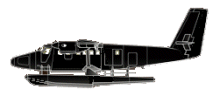Incident Overview

Description
A de Havilland Canada DHC-6 Twin Otter seaplane sustained substantial damage in a landing accident in the Hulhumal Lagoon near Mal-Velana International Airport, Maldives. All occupants survived the accident. The aircraft was flying tourists from the Niyama Resort, Dhaalu atoll, back to Mal. The captain taxied and did the take-off from Niyama because the winds were observed around 15kts, with rough sea conditions. After the aircraft was airborne, passing 1000 ft, the captain handed over the controls to the co-pilot to continue the rest of the flight to Velana International Airport. As the aircraft approached Velana International Airport, both the captain and the co-pilot noticed inclement weather approaching from the west. According to the crew, at 300ft the aircraft was configured for landing with full flaps and propeller levers at the full forward position. Wind shield wipers were turned on due to the light rain. The visibility deteriorated when the aircraft approached to land. Right after the aircraft first contacted water, the visibility briefly dropped to near zero due to heavy rain. The aircraft touched down in the intended landing area, on the left float first and bounced, then contacted the water a second time on the right float. The co-pilot reduced power by pulling the power levers back. At the same time, as stated by the captain, he placed his right hand on the power levers (over the co-pilots left hand) and pushed the power levers fully forward, applying full power with the intention of going around whilst calling “Max power”. The captain neither announced that he was taking over control, nor called for flaps 10ø, as per the procedures. There was no response from the co-pilot in handing over of controls to the captain. The aircraft banked sharply to the right, turning right and crashed. The aircraft finally flipped over and came to rest upside down, facing south and was partly submerged. All passengers and crew evacuated safely through the right hand emergency exit, which was above the water. Causes: a. Improper recovery techniques from a bounced landing; application of go-around procedures whilst the aircraft was at low speed with flaps fully extended. b. Breakdown of crew coordination during the attempted go-around. c. Poor judgement of approaching inclement weather condition; crew decided to land, hoping that they could make it before the approaching storm strikes the landing area.
Source of Information
https://english.sun.mv/45446https://english.sun.mv/45446Primary Cause
Improper recovery techniques during a bounced landing, combined with a failed go-around attempt due to lack of coordination and a failure to announce the go-around.Improper recovery techniques during a bounced landing, combined with a failed go-around attempt due to lack of coordination and a failure to announce the go-around.Share on:

